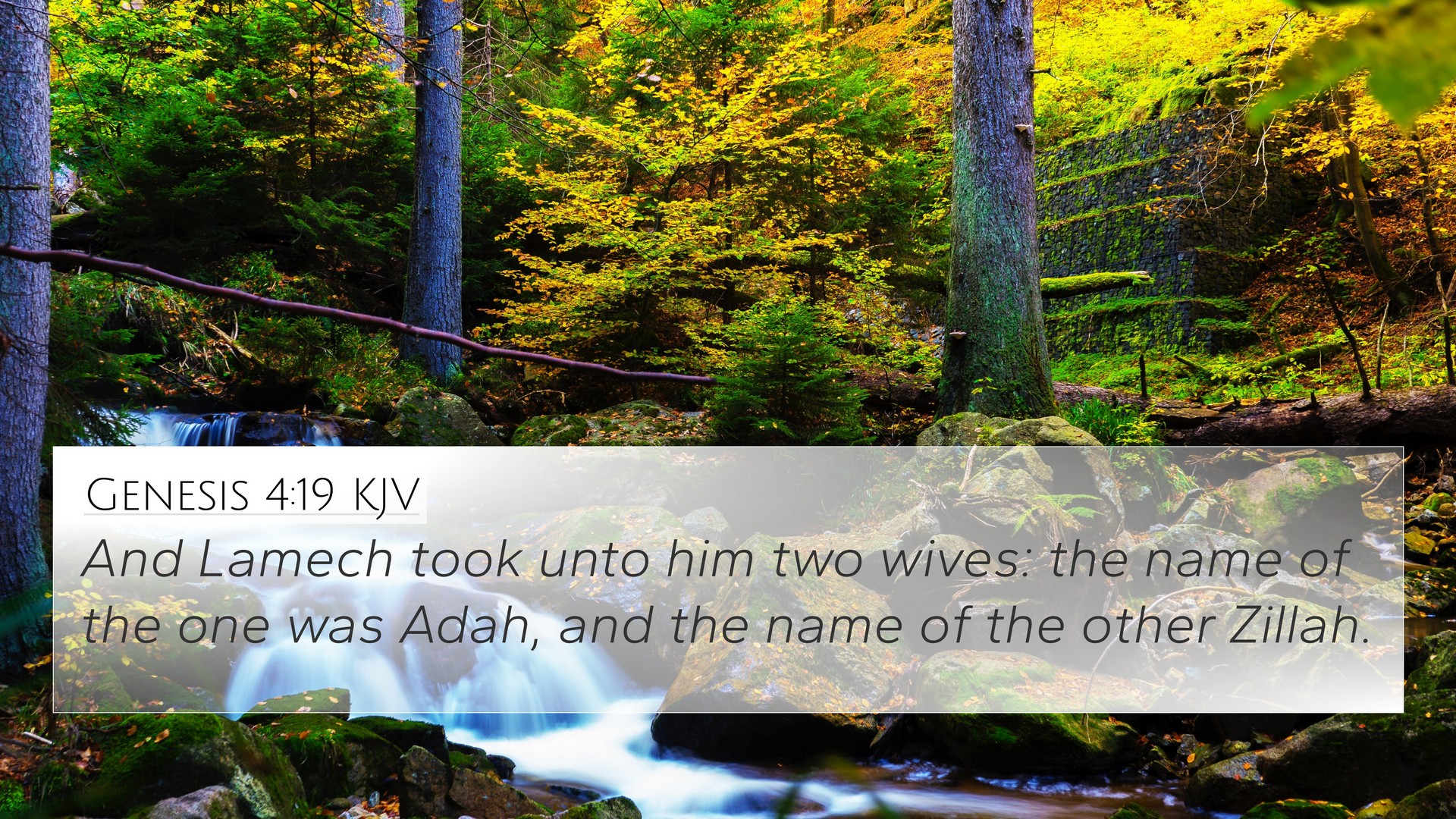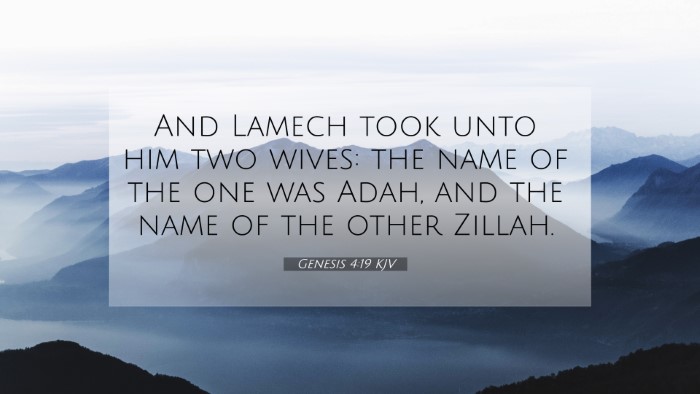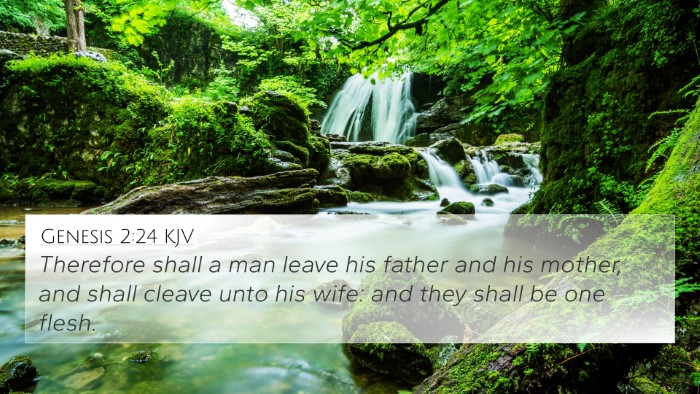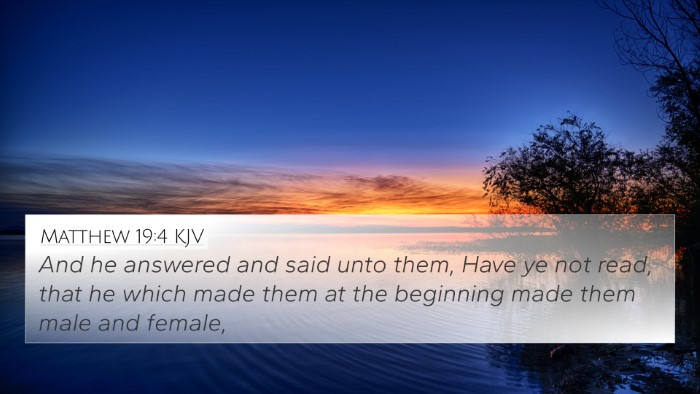Bible Verse Meaning: Genesis 4:19
Verse: Genesis 4:19 - "And Lamech took unto him two wives: the name of one was Adah, and the name of the other Zillah."
Summary of Insights
This verse marks a significant development in the lineage of Cain, illustrating the early practice of polygamy. Lamech's action introduces complexities in human relationships which can be viewed through various Biblical perspectives.
Commentary Insights
-
Matthew Henry:
Henry notes that Lamech's taking of two wives reflects a departure from God's original design for marriage, which was between one man and one woman. This act signifies a growing influence of sin and human deviation from divine ordinance, as Lamech boasts about his actions, indicating pride and rebellion against God.
-
Albert Barnes:
Barnes comments on the significance of names given to the wives, Adah meaning 'ornament' and Zillah meaning 'shade'. This suggests that Lamech's choices were based on aesthetic and practical considerations, further emphasizing his worldly priorities over spiritual virtues. Barnes also draws parallels to Jesus' teachings about marriage.
-
Adam Clarke:
Clarke discusses how Lamech's dual marriages indicate the escalation of corruption in human behavior, linking it to the societal norms of the time. He also intertwines discussions from later scriptural texts, demonstrating how early instances of polygamy foreshadow conflicts within the family structures seen throughout the Bible.
Biblical Cross References
- Genesis 2:24 - Establishes the foundation of marriage.
- Matthew 19:4-6 - Jesus reaffirms the original design of marriage.
- Genesis 6:2 - Further examples of sons of God taking multiple wives.
- 1 Timothy 3:2 - Discusses the qualifications for church leaders regarding marriage.
- Titus 1:6 - Reiterates the importance of monogamy for church leaders.
- Malachi 2:14-16 - Speaks against unfaithfulness and emphasizes the sanctity of marriage.
- Proverbs 5:15-18 - Encourages faithfulness to one's wife; contrasting Lamech's actions.
- Exodus 20:14 - Commandment against adultery, highlighting moral codes pertaining to marriage.
- 1 Corinthians 7:2-3 - Discusses the marital obligations as contrasted to Lamech's practices.
- Hebrews 13:4 - Honors marriage as honorable, with implications towards faithfulness.
Understanding the Thematic Connections
The mention of Lamech taking multiple wives connects to broader themes of sin, the degradation of familial structures, and the shifting norms of society away from divine intentions. The actions and choices of Lamech serve as a narrative that illustrates the consequences of deviating from God's design. It sets the stage for the ensuing implications of unchecked desires and the need for redemption, recurrent themes throughout the scriptures.
Comparative Analysis with Other Scripture
In the context of biblical understanding, examining Genesis 4:19 against other verses allows for an inter-Biblical dialogue that highlights how early practices inform later teachings and moral instructions. The analysis of Lamech's actions through the lens of New Testament scriptures reveals the evolving understanding of marriage and relationships.
Practical Applications for Cross-Referencing
Using tools for Bible cross-referencing enhances comprehension of the scriptural narrative:
- Bible Concordance: Aids in locating passages related to themes of marriage and relationships.
- Bible Cross-reference Guide: Can be invaluable in tracing thematic occurrences of polygamy and its implications.
- How to Use Bible Cross-references: Learning to identify patterns in scripture can facilitate deeper insights and facilitate sermon preparation.
- Cross-referencing Bible study methods: These methods allow for a cohesive understanding of biblical themes by comparing verses across the Old and New Testament.
Concluding Thoughts
Genesis 4:19 demonstrates the complexities that arise in human relationships even from early biblical times. The actions of Lamech provide a starting point for discussions about the sanctity of marriage, the impact of sin on family structures, and the continuous call to return to God's design throughout scripture. By engaging in comparative Bible verse analysis and utilizing cross-referencing tools, deeper insight can be gained into the connections between various biblical texts, ultimately enriching one's understanding of the full narrative of the Bible.






